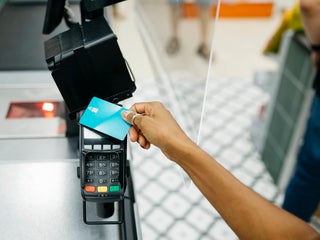Summary
Americans are worse tippers now than before the pandemic. Learn the latest about tipping trends and etiquette in 2022.
The content on this page is accurate as of the posting date; however, some of our partner offers may have expired. Please review our list of best credit cards, or use our CardMatch™ tool to find cards matched to your needs.
Since we’ve entered into the “endemic” phase of the COVID-19 pandemic, many have expected Americans to return to pre-COVID-19 spending habits. So far, there have been mixed results.
Although more than one-third of Americans pledged to become better tippers in 2020 and 2021 in order to support those who had lost wages during the pandemic, the commitment doesn’t seem to have fully materialized. According to a new CreditCards.com tipping survey, Americans are slightly worse tippers now than they were before COVID-19 hit.
“Inflation is cutting into consumers’ purchasing power and a tight labor market has left many service industry businesses understaffed and struggling to provide top-notch customer experiences,” said Ted Rossman, senior industry analyst at CreditCards.com.
Tipping was already a confusing topic, and the pandemic has made it even more so. While more than one-third of Americans promised to be better tippers back in 2021, it seems that sentiment has worn off, he added.
And the survey confirmed this hunch, revealing that the number of restaurant goers who always tip servers or waitstaff at sit-down restaurants has been decreasing steadily – from 77% in 2019 to 75% in 2021 to 73% in 2022.
Tipping at sit-down restaurants
Since tipping at restaurants seems to be the most relatable context for the practice, it’s helpful to use it as a reference point in tipping trends. Among those who go to restaurants, here’s what we found regarding tipping servers in these settings:
- 73% always tip.
- 14% tip most of the time.
- 9% tip sometimes.
- 4% never tip.
Furthermore, 2022 tipping trends still tend to follow differences we noted among generations and even income levels from our 2021 tipping poll. Our survey showed that just 52% of Gen Zers (ages 18-25) who go to sit-down restaurants and 60% of millennials (ages 26-41) always tip restaurant servers, compared with 77% of Gen Xers (ages 42-57) and 87% of baby boomers (ages 58-76). Adding gender into the mix, 78% of women but just 68% of men always tip restaurant servers.
And here’s how income levels affect tipping trends:
Dining tipping averages increase with income – from 19% for those with less than $50,000 in annual household income to 21% for those with incomes between $50,000 and $79,999 to 22% for those with incomes between $80,000 and $99,999 and 26% for those with incomes of over $100,000.
What does tipping look like for other services?
While most people agree that waitstaff should be tipped, some are not really sure what to do when it comes to other services. Here’s how often those Americans who use each of the following tip other service providers:
- Taxi/rideshare drivers: 43% always tip, 23% tip most of the time, 21% tip sometimes and 13% never tip.
- Hotel housekeepers: 27% always tip, 21% tip most of the time, 27% tip sometimes and 26% never tip.
- Coffee shop baristas: 22% always tip, 22% tip most of the time, 33% tip sometimes and 22% never tip.
- Furniture/appliance delivery workers: 17% always tip,19% tip most of the time, 23% tip sometimes and 41% never tip.
- When picking up takeout food: 13% always tip, 17% tip most of the time, 30% tip sometimes and 39% never tip.
U.S adults who use each of these services and say they always tip:
| 2019 | 2021 | 2022 | |
|---|---|---|---|
| Servers at a sit-down restaurant | 77% | 75% | 73% |
| Hairstylists/barbers | 63% | 63% | 66% |
| Food delivery people | 63% | 59% | 57% |
| Taxi/rideshare drivers | 49% | 48% | 43% |
| Hotel housekeepers | 27% | 28% | 27% |
| Coffee shop baristas | 24% | 23% | 22% |
| When picking up takeout food | N/A | 17% | 13% |
| Furniture/appliance delivery workers | N/A | N/A | 17% |
| Home services/repair people | N/A | N/A | 12% |
Consumer tipping poll key findings
Notable findings from the survey include:
- Men versus women on restaurant tipping: Men and women both give a median tip of 20%, but the mean is a little higher among men (22% versus 20% for women).
- Men versus women on grooming and delivery services: Women tip more often in both cases – 70% said they always tip their stylists and only 60% of men said they always tip for grooming services. Sixty-two percent of women always tip food delivery people while only 52% of men said they do.
- Suggested tip amounts have some effect, but not on most: Among people who have encountered suggested tip amounts (for example, at a coffee shop, a food truck, a taxi/rideshare, etc.), most (62%) say their tipping habits are about the same. Twenty-six percent are inspired to tip more (7% said much more and 18% somewhat more), while 12% tip less as a result (5% said much less and 7% somewhat less).
- Northeasterners and Westerners tip more when presented with tip suggestions: Thirty-one percent of Northeasterners and 31% of Westerners tip more when they are presented with pre-filled tipping options, compared with 24% of Southerners and 20% of Midwesterners.
- Tipping favors grooming and food delivery services: Among people who use these services, 66% of people reported always tipping for grooming services and 57% reported always tipping for food delivery services.
Quick guidelines on tipping etiquette
If you aren’t sure when and how much to tip, here are some suggestions that will come in handy:
Do
- Get familiar with tipping guidelines: Although you might get confused regarding the best practices for tipping, you can look up guidelines for common scenarios (see the chart below).
- Carry cash: Avoid the awkwardness of not being able to tip when you want to. Although some people accept peer-to-peer payments in a pinch, it’s still good to have cash handy for tipping.
- Ask about tipping: If you aren’t entirely sure about tipping in a particular scenario, ask your service provider. A simple, “May I tip you?” can clear up confusion about tipping in most situations.
Don’t
- Stiff for bad service: Often, tips are built into the structure of compensation, especially for restaurant waitstaff. Reconsider withholding a tip if you only experienced slight inconveniences with your service.
- Be swayed by suggested tips: Tips aren’t necessary in every situation. Cashiers ringing up orders are an example of when it’s OK to decline those automated tip suggestions. Also, feel free to ignore suggested tip percentages and tip according to your comfort level instead.
Tipping guidance for 2022
These tipping guidelines for common scenarios from national etiquette expert Diane Gottsman can help.
| Setting | Service person | Scenario | Tip amount |
|---|---|---|---|
| Sit-down restaurant | Server/waitstaff or bartender who serves you a full meal at the bar | Drinks and a meal | Tip a minimum of 15% to 20%, or more for exceptional service. |
| Breakfast/lunch restaurant | Staff who fill water glasses and clear dishes | Self-service buffet | Tip $1 to $2 per diner. |
| Restaurant | Cashier | Picking up takeout | A tip isn’t required, but a few dollars is a nice gesture. |
| Taxi or rideshare | Driver | Getting a ride | Tip a minimum of 15%, and 20% or more if they assist you with heavy luggage. |
| Grocery or discount store | Employee/shopper | Curbside pickup | Most stores don’t allow tipping, but a few dollars is nice if allowed. |
| Restaurant meal delivery | Delivery driver | Getting a meal delivered to you | Tip a minimum 20% or $5, whichever is higher. |
| Hotel | Housekeeper | Getting your room cleaned daily | Tip $3 to $5 per day, and don’t wait until the end of your stay to tip since staffers change. |
Survey methodology
CreditCards.com commissioned YouGov Plc to conduct the survey. All figures, unless otherwise stated, are from YouGov Plc. Total sample size was 2,610 adults. Fieldwork was undertaken online from May 11 to May 13, 2022.
Editorial Disclaimer
The editorial content on this page is based solely on the objective assessment of our writers and is not driven by advertising dollars. It has not been provided or commissioned by the credit card issuers. However, we may receive compensation when you click on links to products from our partners.





